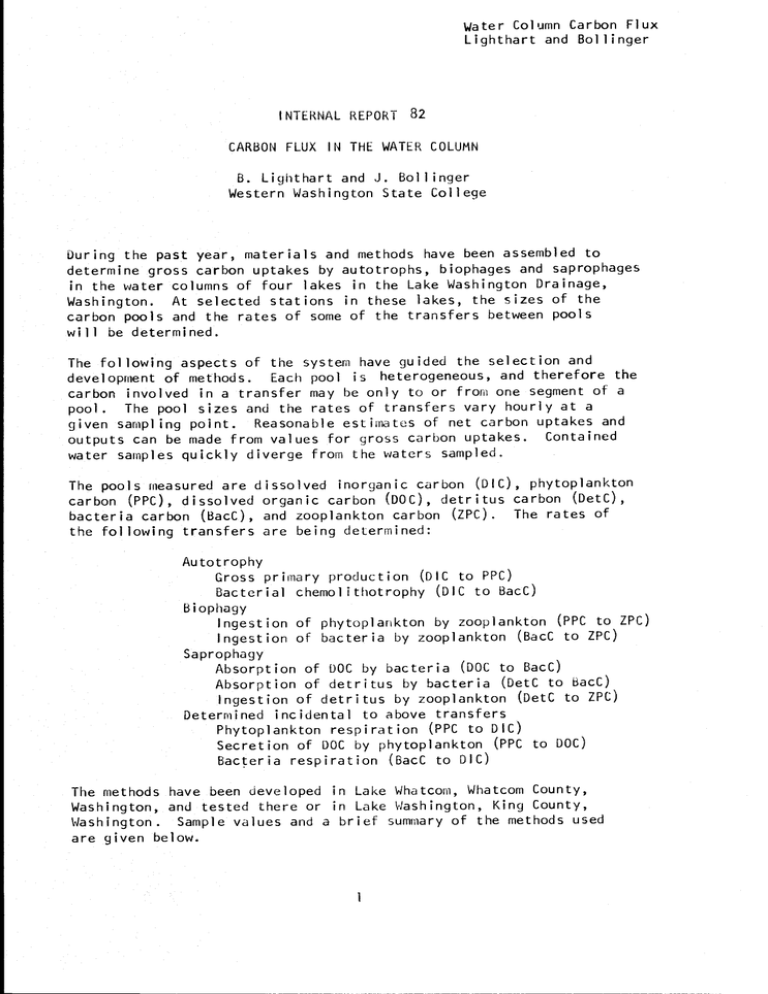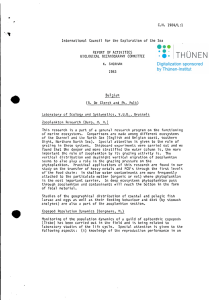B. Lighthart and J. Bollinger and Bollinger
advertisement

Water Column Carbon Flux Lighthart and Bollinger INTERNAL REPORT 82 CARBON FLUX IN THE WATER COLUMN B. Lighthart and J. Bollinger Western Washington State College During the past year, materials and methods have been assembled to determine gross carbon uptakes by autotrophs, biophages and saprophages in the water columns of four lakes in the Lake Washington Drainage, Washington. At selected stations in these lakes, the sizes of the carbon pools and the rates of some of the transfers between pools will be determined. The following aspects of the system have guided the selection and development of methods. Each pool is heterogeneous, and therefore the carbon involved in a transfer may be only to or from one segment of a pool. The pool sizes and the rates of transfers vary hourly at a given sampling point. Reasonable estimates of net carbon uptakes and outputs can be made from values for gross carbon uptakes. Contained water samples quickly diverge from the waters sampled. The pools measured are dissolved inorganic carbon (DIC), phytoplankton carbon (PPC), dissolved organic carbon (DOC), detritus carbon (DetC), bacteria carbon (BacC), and zooplankton carbon (ZPC). The rates of the following transfers are being determined: Autotrophy Gross primary production (DIC to PPC) Bacterial chemolithotrophy (DIC to BacC) biophagy Ingestion of phytoplankton by zooplankton (PPC to ZPC) Ingestion of bacteria by zooplankton (BacC to ZPC) Saprophagy Absorption of DOC by bacteria (DOC to BacC) Absorption of detritus by bacteria (DetC to bacC) Ingestion of detritus by zooplankton (DetC to ZPC) Determined incidental to above transfers Phytoplankton respiration (PPC to DIC) Secretion of DOC by phytoplankton (PPC to DOC) Bacteria respiration (BacC to DIC) The methods have been developed in Lake Whatcom, Whatcom County, Washington, and tested there or in Lake Washington, King County, Washington. Sample values and a brief summary of the methods used are given below. 1 Water Column Carbon Flux METHOD POOL/TRASFER I 2 3 4 DIC 5 6 BacC ZPC 7 S 10 11 12 13 14 15 16 2,020 ugC/l DEPTH TIME M 1200 hr 1 PPC 105 1 DOC 2,420 1 5 1 DetC 3.4 DIC to PPC 27 ugC/l/hr DIC to BacC 0 PPC to ZPC 0.62x10-3 BacC to ZPC 0.027x10-3 DOC* to BacC 0.31 DetC* to BacC 13.4x1O DetC* to ZPC 2.94x10j -3 PPC to DIC 14.(,> PPC to DOC 7.55 BacC to DIC 0.16 ttC 3 1 3 3 1 1 3 1 1 1 and Bollinger DATE LOCATION 12 Oct 12 Oct 12 Oct 12 Oct 12 Oct 26 Oct 1000-1500 12 Oct 1000-1500 12 Oct 1330 26 Oct 1400 26 Oct 1000-1500 12 Oct 0900-1500 04 Aug 1530 26 Oct 1000-1500 12 Oct 1000-1500 12 Oct 1000-1500 12 Oct 1200 1200 1200 1200 1300 0.368 *DO 1 1. SIZE/RATE Lighthart Lk. Washington Lk. Washington Lk. Washington Lk. Washington Lk. Washington Lk. Washington Lk. Washington Lk. Washington Lk. Washington Lk. Washington Lk. Washington Lk. Whatcom Lk. Washington Lk. Washington Lk. Washington Lk. Washington and Detl4 C produced in Lake Whatcom The amount of dissolved inorganic carbon is taken as the difference between a water sample containing DIC and DOC and one that has been freed of DIC. DOC is determined by oxidation of a DIC-and-particle-freed sample in a closed ampule followed by infrared photometry to measure the amount of CO2 formed (1). In this procedure, DIC is removed by acidifying and purging the sample before the ampule is sealed. DIC plus DOG is determined from a sample that is placed in an ampule with the oxidant; the gas phase above the sample is purged of CO21 acid is added, and the ampule quickly sealed. The amount of phytoplankton carbon is calculated from the volume of phytoplankton, which is determined by microscopy of fixed samples. 2. 3. Method is given in 1. The volume of detritus is determined by visual estimation during the determination of phytoplankton volume. A percentage of this volume is taken as the estimate of the amount of detritus carbon. Alternately, microseston (particles which pass through a net with 150u openings) is collected on a glass fiber filter, the filter and sample are combusted in a closed ampule with oxygen, and the amount of CO2 formed is measured 4. by infrared photometry (2). The amount of detritus carbon is calculated by subtracting the amount of phytoplankton and bacterial carbon from the value obtained for microseston carbon. 5. The amount of bacterial carbon is calculated from the number of bacteria. Bacteria are stained with acridine orange and enumerated by observation with fluorescent microscopy. The amount of zooplankton carbon is calculated as 50 percent of the ash-free dry weight of the zooplankton. 6. 2 Water Column Carbon Flux Lighthart 7. and Bollinger Gross primary production is determined by the traditional method of measuring the changes in oxygen concentrations in water samples contained in clear and light-tight bottles (3). Alternately, it is calculated by summing the amount of carbon respired by phytoplankton (see 14 below), with net carbon gained, and the amount of carbon secreted Net carbon gained is determined by measuring the as DOC (see 15 below). amount of carbon-14 incorporated into the particle phase when a water sample is incubated with NaHt4CO3(3). CYnmolithotrophy by bacteria is determined by measuring the uptake C by the particulate phase in a light-tight bottle. An estimate of carbon lost due to bacterial respiration is added to the amount fixed to obtain a value for gross uptake. 8. of DI Ingestion of phytoplankton by zooplankton is determined by first labelling phytoplankters with carbon-l4 and then feeding them to zooplankters. The zooplankters are then collected and uptake measured by scintillametry. 9. 10. Ingestion of bacteria by zooplankton is measured by first labelling bacteria with glucose-14C and then feeding them to zooplankters. H. Absorption of DOC by bacteria is determined by incubating lake water with D0 14C followed by $$cintillametry of the particulate phase (bacteria) to measure uptake. DOI C is prepared by fractionating lake water that has been incubated with NaH14CO3. 12. Absorption of detritus by bacteria is estimated from the amount of Detl4C is DI14C formed when lake water is incubated with Det14C. prepared by fractionating lake water that has been incubated with NaH C03 U. Ingestion of detritus by zooplankton is determined by feeding Det14C to zooplankters followed by scintillametry of the zooplankters. 14. Phytoplankton respiration is calculated by subtracting bacterial respiration from the respiration of zooplankton-freed lake water. The determination of bacterial respiration is outlined in 16 below. The respiration of zooplankton-freed lake water is determined by measuring the change in oxygen concentration of a sample contained in a lighttight bottle. 15. A sample of zooplankton-freed lake water is incubated with NaH14CO3 The amount of DOC secreted during to label the phytoplankton present. this incubation is measured by scintillametry of the particle-free fraction. 16. Bacterial respiration is calculat d from the amount of D114C formed when lake water is incubated with DO] C. Originally, it was proposed to determine the rates of transfers of five three-compartment subsystems by the methods of Saunders. The proposed Water Column Carbon Flux Lighthart and Bollinger methods had incubation times up to 24 hours in duration, with intermittent sampling. These methods yield graphs of change versus time for kinetic analysis. The current methods have shorter incubation times, with subsampling only at the beginnings and at the ends of the incubations. This estimated. approach yields midday rates, from which whole day rates can be The proposed methods had no controls for divergence of contained samples The present methods attempt to reduce this artifact from the waters sampled. by using shorter incubation times. Another problem with the proposed methods of determining transfer rates was that they were unwieldy if attempted all at once. The current methods also suffer from this shortcoming. This has prompted continued research into modifying the methods and reducing the number of transfer rates measured DIC to PPC, DIC to BacC, PPC to ZPC, DetC to ZPC,BacC to ZPC, to six: and DOC plus DetC to BacC. A carbon-l4 method for determining gross primary production by using incubation times of less than an hour is being investigated. The zooplankton ingestion rates are calculated from ten-minute exposures to labelled substrates, and therefore these methods do not have to be modified to obtain shorter manipulation time . Method4 are being sought for increasing the specific activities of D014 and Detl`+C, so that less time is needed for labelling them, and shorter incubation times are required to measure the metabolism of these substrates by bacteria. Hopefully, by further modifying and consolidating the methods, more sampling points can be done in a day. This would allow for the direct determination of day rates by assaying a given station more than once a 24-hour period. in REFERENCES Exploring the aquatic carbon web. 1972. LIGHTHART, B., and P. E. TIEGS. Proceedings-J. F. Franklin, L. J. Dempster, and R. H. Waring (eds.). IN: USDA Forest Research on Coniferous Forest Ecosystems--A symposium. Service, Portland, Oregon. MENZEL, D. W., and R. F. VACCARO. 1964. STRICKLAND, J. D. H., and T. R. PARSONS. Bull. 167. Limnol. Oceanogr. 1968. 9:138-142. Fish. Res. Bd. Canada, A manual on methods for measuring primary 1969. VOLLENWEIDER, R. A. (ed.) F. A. IBP Handbook No. 12. production in aquatic environments. Davis Co., Philadelphia, Pennsylvania. 4




